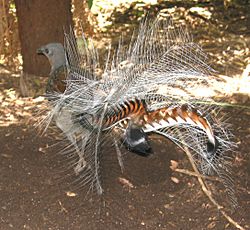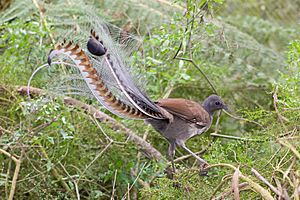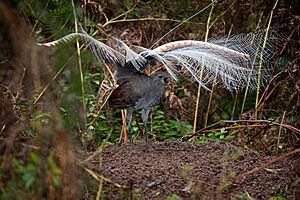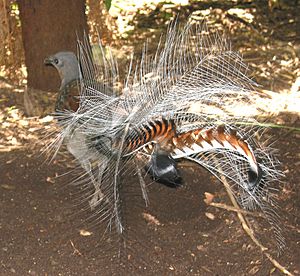Superb lyrebird facts for kids
Quick facts for kids Superb lyrebird |
|
|---|---|
 |
|
| Conservation status | |
| Scientific classification | |
| Kingdom: | |
| Phylum: | |
| Class: | |
| Order: | |
| Family: | |
| Genus: | |
| Binomial name | |
| Menura novaehollandiae Latham, 1801
|
|
The superb lyrebird (Menura novaehollandiae) is a special type of songbird found only in Australia. It's about the size of a pheasant. This amazing bird lives only in Australia and can grow up to 100 cm (about 3.3 feet) long. It has brown feathers on its back and grayish-brown feathers underneath. It also has rounded wings and strong legs. It is the longest and third heaviest of all songbirds.
Superb lyrebirds are famous for being able to copy many different sounds. They can mimic other bird songs, and even human-made sounds like car alarms and chainsaws!
Contents
Where Do Superb Lyrebirds Live?
The superb lyrebird lives only in Australia. You can find them in the forests of south-eastern Australia. Their home stretches from southern Victoria up to south-eastern Queensland.
Some lyrebirds were moved to southern Tasmania between 1934 and 1954. People were worried that the birds might disappear from the mainland. Luckily, the Tasmanian population is doing very well and growing! In most other places, the superb lyrebird is common. Experts say it is a species of least concern on the IUCN Red List of Threatened Species. This means they are not currently in danger of extinction.
These birds live in many different types of forests. This includes warm, wet rainforests and also drier sclerophyll forests. They especially like wet forests and rainforests. These places have lots of moist leaves on the ground under shady trees. When the weather is good, lyrebirds might even explore drier areas further from water.
What Does a Superb Lyrebird Look Like?
The superb lyrebird is a large ground-dwelling passerine (songbird). Females are about 86 cm (34 inches) long, and males can be up to 1 meter (39 inches) long. Females weigh around 0.9 kg (2 pounds), and males weigh about 1.1 kg (2.4 pounds). Their feathers are mostly dark brown on top, with grayish-brown underneath. Their flight feathers have a reddish tint.
Their wings are short and round. They are not strong fliers. They mainly use their wings for balance or for gliding from trees to the ground. Their legs are very powerful, helping them run fast. Their feet are strong enough to move branches up to 10 cm (4 inches) thick!
Amazing Tails
Lyrebirds are famous for their fancy tails. Adult males have tails that can be up to 70 cm (28 inches) long. These tails have sixteen special feathers. The two outer feathers are shaped like an "S" and are called "lyrates." They look a bit like the ancient musical instrument called a lyre. These feathers have brown and buff patterns.
Between the lyrates are twelve thin, flexible feathers called "filamentaries." In the very middle of the tail are two shiny, silvery feathers. Female lyrebirds have simpler tails. Their lyrates are shorter, and their other feathers are plain and broad. Young lyrebirds, called juveniles, do not have these fancy tail feathers. Their tails grow into the adult look over several years. Male superb lyrebirds become fully grown at 7–9 years old, and females at 6–7 years old.
How Superb Lyrebirds Live
Superb lyrebirds usually live alone on the ground. Adult birds often have their own territories. However, young birds without a territory might hang out in small groups. Lyrebirds don't fly much and don't move around a lot. They often stay in the same area their whole lives. Their territories are usually small.
What Do They Eat?
Superb lyrebirds mostly eat invertebrates. These include earthworms and insects found on the forest floor. They also seem to eat fungi.
They find food by scratching hard in the top layers of the soil. This stirs up the topsoil and leaf litter. They are most likely to search for food in damp rainforest areas. They also prefer places where the plants on the ground are not too thick, making it easy to reach food.
Mating and Reproduction
Superb lyrebirds have a mating system where one male mates with several females. This is called polygyny. A male's territory can overlap with up to six female territories. Inside his territory, the male builds several round mounds of bare dirt on the forest floor. He uses these mounds for his courtship displays. He protects these mounds strongly from other males.
When a male meets a female lyrebird, he performs a fancy courtship show on the closest mound. This show includes both singing and dancing. The male spreads his tail feathers out flat to cover his whole body and head. He vibrates his tail feathers, flaps his wings against his body, and struts around the mound. He also sings loudly, mixing his own calls with mimicry of other bird calls. Scientists have found that the lyrebird's "dance" matches his different songs very well. This ability to coordinate movement with sounds was once thought to be unique to humans. It shows how smart these birds are!
Only the female lyrebird takes care of the young. She builds large, dome-shaped nests out of sticks on raised areas of earth. Nests are often found in wetter areas with deep leaf litter and lots of plants nearby. This helps them find food and stay safe from predators.
The female lays eggs once a year in winter. She usually lays just one egg. The egg rests on a soft bed of lyrebird feathers inside the nest. The female then sits on the egg to keep it warm, a process called incubation, for up to 7 weeks. After the chick hatches and leaves the nest, the mother continues to feed and care for it for several months. This takes a lot of energy from the female.
Amazing Voices and Mimicry
The superb lyrebird is famous for its amazing mimicry. About 70-80% of the male's songs are imitations of other bird species. Females also sing and can mimic sounds, but not as much as the males. Their copied sounds can be mixed with their own special lyrebird songs, calls to mark their territory, and alarm calls. Their songs follow clear patterns, with different parts repeated in certain ways.
The superb lyrebird's mimicry is incredibly accurate. Sometimes, the original bird cannot even tell the difference between its own song and the lyrebird's copy! For example, one study found that strike-thrushes reacted the same way to their own songs as they did to lyrebirds copying them.
Young lyrebirds usually learn to mimic sounds from older lyrebirds, not directly from the original birds. For instance, lyrebirds in the Sherbrooke Forest in Victoria often copied the song of pilotbirds. But pilotbirds had not been seen in that area for over 10 years! This suggests the young birds learned the song from other lyrebirds. Also, in winter when chicks hatch, adult lyrebirds copy birds that are less active during that time. This also points to them learning from other lyrebirds.
The quality of their mimicked songs gets better as they get older. Adult superb lyrebirds are more accurate and have more different copied songs than younger birds. Younger lyrebirds can make recognizable copies, but they are not as good as adults. Their copies might not have the same range of sounds, be as consistent, or sound as clear. This is especially true for complex calls like the whipbird call.
Images for kids
-
Menura superba – superb lyrebird (1800) by Thomas Davies
-
John Gould's early 1800s painting of museum specimens of a male superb lyrebird (with tail feathers incorrectly displayed) and a female superb lyrebird
See also
 In Spanish: Ave lira soberbia para niños
In Spanish: Ave lira soberbia para niños








